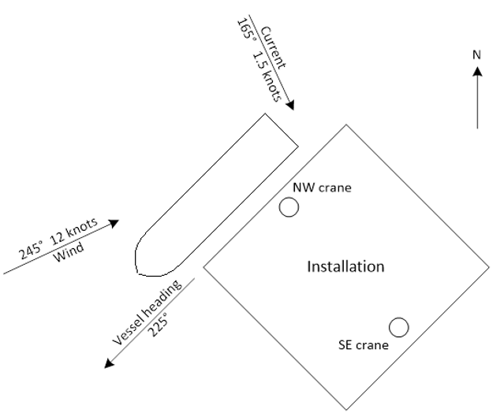Switching to manual mode caused loss of position
- DP Event
- Published on 31 August 2018
- Generated on 3 July 2025
- DPE 03/18
- 3 minute read
Incident
Jump to:
A DP2 platform supply vessel was set up on auto DP engaged in cargo operations inside the 500m zone of a fixed platform.
Overview
The DP design concept of the vessel was such that there were two redundant groups and the vessel was set up with power generation and thruster supplies equally split across each redundant group with main bus ties open.
Weather conditions were acceptable based on the capability of the vessel and the vessel was undertaking cargo offload on the north west side of the platform on a “blow on” position due to unavailability of the south east side platform crane.

The port aft azimuth developed a failure that led to it tripping out of DP control and its main circuit breaker opened. As the vessel was being operated within its environmental envelope and the thruster failure did not exceed the designed worst case failure, the vessel maintained position.
However, as redundancy had been compromised cargo operations were immediately suspended and the instruction was given to leave the 500m zone for thruster investigation. The DPO, in consultation with the master, decided to deselect auto DP control mode and selected manual control mode, at which point the vessel became unable to maintain its position and light contact was made with the platform before vessel control was regained. The decision was made to return to port for investigation.
Investigation highlighted that when auto DP is deselected, all thruster setpoint references move to zero for the deselected surge, sway and/or yaw axis therefore when the DPO selected the vessel to manual control all thrusters effectively stopped producing force leading to the loss of position.
The standard operating procedure for the DP system was dictated by the vessel’s DP operations manual and the vessel was set up for DP operations accordingly. The vessel had two redundant groups and the redundancy concept was such that the groups were operated separately. The vessel did not experience a failure worse than its designed worst case failure and it maintained position post thruster failure.
Lessons learned
The decision to switch out of auto DP control in order to manoeuvre the vessel out of the 500m zone resulted in the vessel’s position loss and contact with the platform. This decision was incorrect and the DPO had a lack of knowledge regarding how the system should perform. Had DP control been maintained, the vessel could have been manoeuvred away from the platform without harm.
The DP operations manual did not explicitly state what actions should be taken in the event of a major DP system component failure nor did it explain the consequences on station keeping during DP control mode changes.
Conclusion
This case study demonstrates the importance of good understanding of the DP system and its redundancy concept such that in the event of a failure, sound judgement can be taken.
The vessel in question was a platform supply vessel and by nature spends a much higher percentage of time in transit/port than in field in auto DP mode. In this type of scenario, it is vital that the DP crew are exposed to annual DP trials and regular DP exercises and drills so that experience and confidence in the system is gained during normal and failure condition.
Familiarisation and training of change of thruster control mode should be a regular part of on board training.
Latest DP incidents
-
Complete the job
Whilst connected to a turbine, an alarm was generated on the DP operator station, ‘Unbalanced load on SWBD 1’.
DPE 01/25
16 January 2025
Undesired event
-
How is your alignment?
Loss of the CyScan position reference system generated a reference system failure alarm and moments later the vessel began to lose position with the accompanying alarms.
DPE 01/25
16 January 2025
Incident
-
Beware your centre of rotation
The stern thrusters started to oscillate which transferred to an oscillating motion of the vessel and high forces were being used to try to maintain position.
DPE 01/25
16 January 2025
Incident
-
A-Tension
Whilst pipelaying in shallow water, the vessel experienced a tension sensor failure on one tensioner.
DPE 01/25
16 January 2025
-
DP Drill Scenario
DP emergency drill scenarios are included to assist DP vessel management, DPOs / Engineers, and ETOs in conducting DP drills onboard.
DPE 01/25
16 January 2025
Drill Scenario
The case studies and observations above have been compiled from information received by IMCA. All vessel, client, and operational data has been removed from the narrative to ensure anonymity. Case studies are not intended as guidance on the safe conduct of operations, but rather to assist vessel managers, DP operators, and technical crew.
IMCA makes every effort to ensure both the accuracy and reliability of the information, but it is not liable for any guidance and/or recommendation and/or statement herein contained.
Any queries should be directed to DP team at IMCA. Share your DP incidents with IMCA online. Sign-up to receive DP event bulletins straight to your email.